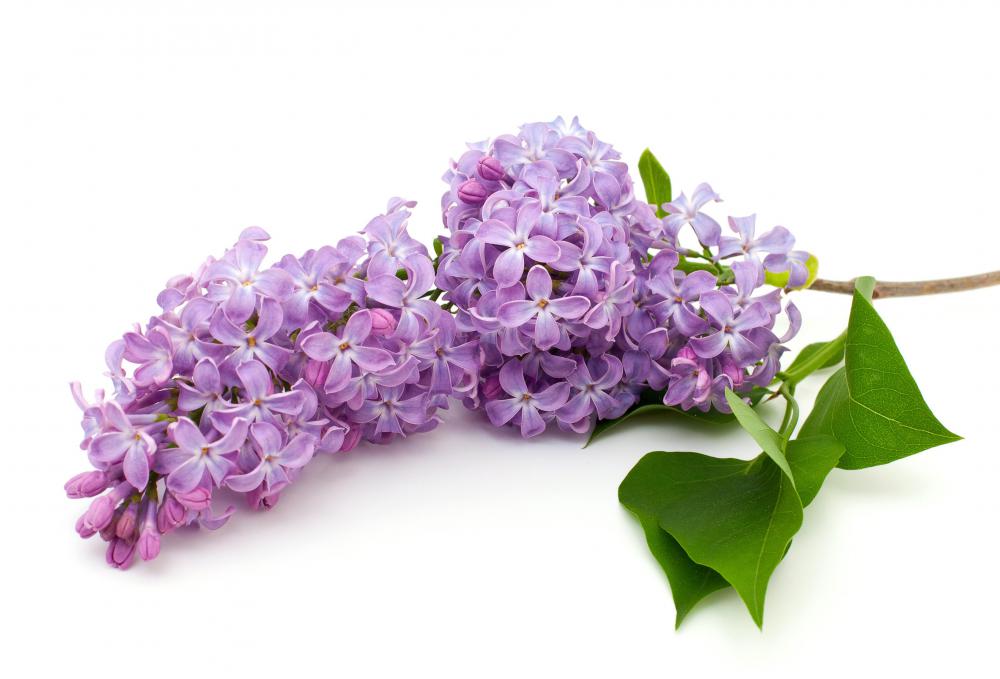At WiseGEEK, we're committed to delivering accurate, trustworthy information. Our expert-authored content is rigorously fact-checked and sourced from credible authorities. Discover how we uphold the highest standards in providing you with reliable knowledge.
What are Lilacs?
Lilacs are highly aromatic ornamental flowers which are particularly prized in old fashioned gardens. Many cultivars are also highly drought tolerant, making them excellent additions to low water gardens since they have rich green foliage in addition to their famous flowers. When lilacs are grown in conditions which they like, they can develop into small trees, and live for hundreds of years. In some regions, lilacs are also known as “pipe bushes,” because of the hollow branches which appear in some young cultivars.
The flowering bush is in the olive family, along with a large number of other ornamental and drought tolerant plants. All lilacs are in the genus Syringa, although several species are commercially cultivated. Most people associate lilacs with white or purple flowers, but lilacs can also bloom in red, yellow, and orange, among other colors. The plants have dark green simple leaves and a bushy growth habit which requires plenty of room in the yard, since cramped quarters can lead to moldy conditions.

The United States has a long tradition of lilac cultivation, especially in New York State. Many famous sites around the United States have ancient lilac bushes, but Rochester, New York has the most impressive collection of lilac cultivars. The city has an annual lilac festival to celebrate the numerous plants of the city, and in 2006 lilacs were designated the official New York State Bush, in recognition of the proud place they have in the state's history.

Like many other drought tolerant plants, lilacs often prefer to be left largely alone. Pruning of the plants should be minimal, and they do well in poor soil, as long as it is well drained. Lilacs should be offered water periodically, but not to excess, and they are hardy as far North as USDA zone four, although extremely cold weather may inhibit the blooming of the plants. Cultivating lilacs is relatively easy, and the plants are easy to obtain from garden stores.

In addition to old fashioned gardens, butterfly gardens also often feature lilacs, since they attract butterflies and other insects. The flowering bushes can also be used in other gardens, of course, although gardeners should be careful about planting them near other aromatic plants, since the scents could potentially clash. Lilacs should also not be planted in close proximity to a structure, since the building may cramp the growth habit of the plant.
AS FEATURED ON:
AS FEATURED ON:














Discussion Comments
@RocketLanch8- We also had a lilac bush in our house in Pennsylvania, but I think we may have needed a few lessons on pruning and planting lilacs. The vines will definitely take over the place if you don't cut them back once in a while, but you also don't want to cut them completely off at the base and hope they grow back. It won't happen for a long time, if it happens at all.
I'm seriously considering growing dwarf lilacs, if I can find a plant nursery around here that has them. I miss the smell of lilacs when they are in full bloom, but I don't want to plant anything that could make life difficult for the next owner of my property.
We had a very large lilac bush planted in front of our living room window when I was a kid. When the lilacs were in full bloom, the smell was unbelievably good. Some of the vines were strong enough to support my weight, so I would actually climb inside the lilac bush and enjoy the view and the fragrance. I still look for air fresheners or scented candles that use lilacs as their fragrance.
Birds and bees also like the beautiful, fragrant lilacs.
Post your comments